That Rainy Day in London Town
How many hours a day, or week, does it take to look after one small roof terrace and a number of plant filled passages? It’s the sort of question that I rather enjoyed at school – if it takes six men 5 days to plough three fields how many days would it take eight men to plough 13 fields?
I have about 75 containers at any one time; with small succulents needing very little attention, small trees (including olives, my favoured Eucalpytus Nicholii, pittosporum and a bay) also on the whole needing very little attention as long as I remember to feed, water and occassionally prune a bit, and a wide range of attention seeking herbaceous and seasonal plants. Not forgetting roses and climbers which are pretty forgiving.
 Access to some parts of the narrowest planted areas is challenging. Watering and feeding involve leaning out of bed-room windows, while anything requiring greater horticultual skill or endeavour also involves clambering out of the same windows, and of course back in again. So best to avoid wrenching a muscle or injuring a foot the wrong side of the bedroom window. In truth the passages all interconnect with the main balcony, but since getting past the containers of roses and other large plants to reach a door is as challenging as clambering back indoors, keeping uninjured is recommended.
Access to some parts of the narrowest planted areas is challenging. Watering and feeding involve leaning out of bed-room windows, while anything requiring greater horticultual skill or endeavour also involves clambering out of the same windows, and of course back in again. So best to avoid wrenching a muscle or injuring a foot the wrong side of the bedroom window. In truth the passages all interconnect with the main balcony, but since getting past the containers of roses and other large plants to reach a door is as challenging as clambering back indoors, keeping uninjured is recommended.
I have very vivid memories of locking myself out of a garden flat in West London. At the time it was still quite a bohemian area, with antique dealers and antiquarian book-sellers dominating the browsing and shopping scene. It later became an expensive high-end retail destination but luckily for me that was yet to come. If you are going to lock yourself out, it’s best to be dressed in rather more than a shabby dressing-gown with bare feet, and better still to be close to a small hotel used to eccentric requests. In that pre-mobile phone era I needed someone to call a locksmith, which the receptionist did, without batting an eyelid, while her colleague was talking to an elegant couple checking out of the hotel. My excuse was that I had ‘flu at the time, and had answered the front door when the postman rang and for some reason then crossed the threshold as the door closed firmly behind me.
I had a lot to be grateful for, although I was also quite shocked by the speed and effortlessness with which the locksmith opened the door, which rather detracted from my faith in expensive locks.
Mid-June, and before wind, rain and yet more wind became the norm after the earlier languid days, I did some rearranging on the main terrace, swapping over a very heavy container with a bay tree, and one of the olives. It was a good idea, and reassuringly easy, as my left shoulder has at long last recovered from an early lockdown injury. Pulling large containers backwards and forwards, through the seasons and for different light conditions, flowering interest and general well-being is a good alternative to other exercise regimes.
And as the weather changed I began to notice the emergence of several, delightful Hellebore flowers, which more usually arrive in time for Christmas.
Be Careful What You Wish For
Now to the plants:
Tall herbaceous perennials surprisingly seem to cope with the cramped conditions, and the extremes of heat and wind, that the relatively small containers and changeable weather has thrown at them.
 Verbena bonariensis heading for the skies, thalictrum delavayi tallest of all at eight foot and more, and the unmemorably named Veronicastrun virginicum ‘Lavendelturm’ (Culver’s foot) are all competing for height and have recently been joined by the pretty spikes of Gaura lindheimeri, which answers to a number of variations of its name. Anyone who is growing thalictrum amongst other tall plants may have discovered that in addition to their delicate beauty they do a very good job of supporting any other tall plants nearby, as long as they themselves have enough support to allow some gentle swaying in the wind without the risk of keeling over.
Verbena bonariensis heading for the skies, thalictrum delavayi tallest of all at eight foot and more, and the unmemorably named Veronicastrun virginicum ‘Lavendelturm’ (Culver’s foot) are all competing for height and have recently been joined by the pretty spikes of Gaura lindheimeri, which answers to a number of variations of its name. Anyone who is growing thalictrum amongst other tall plants may have discovered that in addition to their delicate beauty they do a very good job of supporting any other tall plants nearby, as long as they themselves have enough support to allow some gentle swaying in the wind without the risk of keeling over.

 They are all very beautiful and surprisingly happy; I would recommend them to anyone who wants to sit amongst the summer show, watching the insect world, surrounded by plants of all heights offering different interest. In the quiet of the hot days of the early lockdown the possibility of plants feet taller than me seemed very remote. Now it’s the norm to be outranked, but the colour choice is conservative.
They are all very beautiful and surprisingly happy; I would recommend them to anyone who wants to sit amongst the summer show, watching the insect world, surrounded by plants of all heights offering different interest. In the quiet of the hot days of the early lockdown the possibility of plants feet taller than me seemed very remote. Now it’s the norm to be outranked, but the colour choice is conservative.
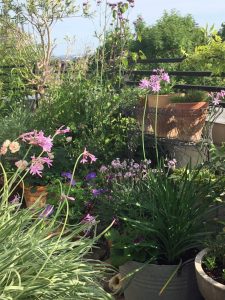 Meanwhile at ground level different varieties of tulbaghia have taken over.
Meanwhile at ground level different varieties of tulbaghia have taken over.
After my success rearing butternut squash and sweetcorn seedlings for the allotment it is my turn now: Aquilegia ‘Lime Sorbet’. You may have a packet too as they came free with June’s edition of Gardener’s World Magazine. While engaging with much of the outside world – talking with friends, music lessons, quizzes or professional meetings, not forgetting shopping, is done remotely, and news comes on-line, a few months ago we reversed the trend and went back to hard-copy for the GW magazine, not so much for the very welcome free seeds but for ease of flitting between articles.
Aquilegias are great plants for pots and flower happily as late Spring turns into Summer. My absolute favourite is Aquilegia vulgaris var. stellata ‘Ruby Port’. It’s a soft deep red, happy in sun or shade and always looks very at home. None this year though as last year’s Autumn planting was interrupted. ‘Lime Sorbet‘ on the other hand is a beautiful soft limey white and will hopefully look good when there’s not much competition around.
Luckily since our local garden centre is open again, having managed to keep going through the bleakest days of the lockdown, I’m hoping to find some seed compost and horticultural grit. My last purchase was a terracotta pot that turned out to be too small for ‘potting on’ my favourite olive, which will now have to make do with some extra seaweed feed. I clearly need to pay more attention to detail before embarking on any more purchases. In many situations an extra, generously proportioned pot, bought half-price, would be something of a bonus, another mini project, something to fill another time. Unfortunately on the balcony it’s created pressure on space that I could really do without as everything is growing well and spilling over into the gangways. So if I remain true to my earlier pledge to ensure that it is always possible to walk across the terrace without undue difficulty, even in high Summer, I must pass it on.
Pests, Weeds and Diseases
The difference between a gardener with a real interest in horticulture and a gardener who wants to have a few favourite plants and trees, that enhance the outdoor space without generating too much hard work, might be exemplified by the following question posed by a nearly 10yr old, while wandering together but yards apart across the Surrey Downs – “what should we be planting now?”
We’ve missed his horticultural wisdom, energetic digging and enthusiastic watering.
Equally enthused by recently planted seeds showing promise, and remarkably patient when growing vegetables, he has a sense of the need to think and plan ahead for the gardening year which I only grasped much later in life. As he already has a cucumber plant, and his broccoli seeds are germinating, beetroot or carrots might be the answer, but I couldn’t come up with anything at the time and instead covered up with a reminder that it was really a growing season rather than a planting season. True, but only up to a point. A good question deserved a better answer.
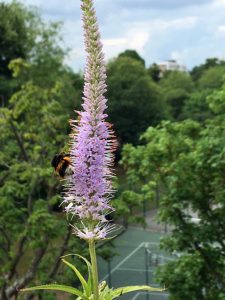 And the answer to the question about how much time does it take to look after the balcony is quite a lot, and always more than I have. However, my hunch is that anyone interested in gardening will often include enough complexity, and be sufficiently susceptible to the allure of another plant or horticultural project, to ensure that there will always be something to to do to fill the time available. My next job is to plant the strawberry plants I have just been given and I do have a suitable container for them.
And the answer to the question about how much time does it take to look after the balcony is quite a lot, and always more than I have. However, my hunch is that anyone interested in gardening will often include enough complexity, and be sufficiently susceptible to the allure of another plant or horticultural project, to ensure that there will always be something to to do to fill the time available. My next job is to plant the strawberry plants I have just been given and I do have a suitable container for them.
If you want to avoid slugs and snails roof-top gardening might be the thing to do. Occasional slugs do appear, presumably transported aloft with a newly acquired plant, and aphids are happy at high altitude, but generally speaking, the combination of hard surfaces, ladybirds and other predators and exposure to wind, rain and direct sunlight, deter many pests and diseases. Weeds seem to be absorbed in the general planting mix and the use of any measures to combat pests and diseases can generally be completely avoided unless you include squashing aphids, which is relatively straightforward.
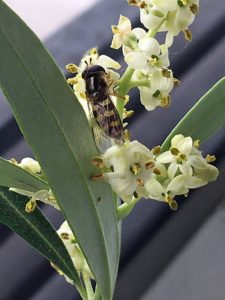 However, oxalis is a lover of containers and enjoys a close association with plants in pots, noticeably my roses and olives. There are apparently over 800 species of oxalis, most being ornamental, but two or three of my largest containers are overrun with this pretty but persistent intruder and removing all remnants requires more patience and determination than I can muster.
However, oxalis is a lover of containers and enjoys a close association with plants in pots, noticeably my roses and olives. There are apparently over 800 species of oxalis, most being ornamental, but two or three of my largest containers are overrun with this pretty but persistent intruder and removing all remnants requires more patience and determination than I can muster.
Any tips would be very welcome.
Meanwhile response to the inclusion of poetry in my last post has been mixed – mostly in favour but some disappointment about the lack of horticultural content, which I can also understand. So if you want another suggestion, at this moment when late June has slipped by, with all this represents, you might try Edward Thomas’s poem ‘Adelstrop’, written in 1914.
While up aloft the drying, damaging wind continues to fling the plants around and some of the thalictrum have lost their trailing tops, at the allotment, adjacent to a large nettle patch, a tortoiseshell butterfly appeared and happily lingered in the flower strip, oblivious to the winds above.



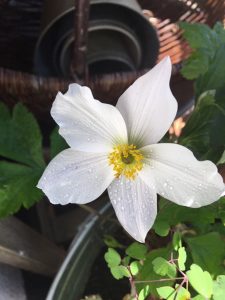

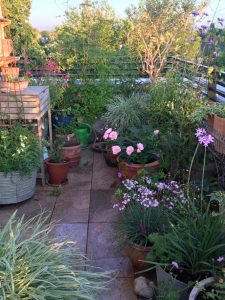

Dear Ann,
Another great tribute of and to your balcony garden; and great photos too, so beautifully incorporated. So glad to know you are flourishing too (as are we so far)
all the best and lots of love,
Sally
Thank you very much for your comment – actually on the balcony things are flourishing rather excessively and reaching the bench now involves negotiating a very beautiful rose about to have a second flush, but nevertheless a nice problem to have.
Considering your beautiful prose and images both physical and imaginary, it seems churlish to point out that tractors these days run on GPS etc so you would only need one man at the most.
I’m reliably informed that the answer is that it would take 16 and a quarter hours to plough the fields, so a tractor and GPS sounds an advance as long as the GPS signal was stable – I’m glad you liked the post and thank you for your comment.